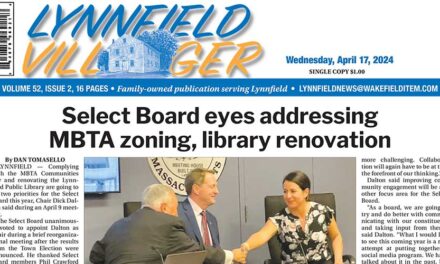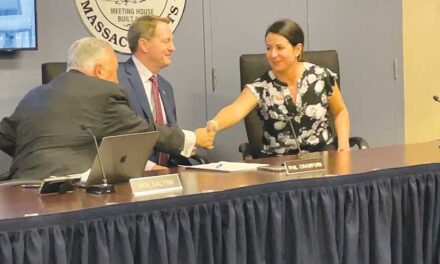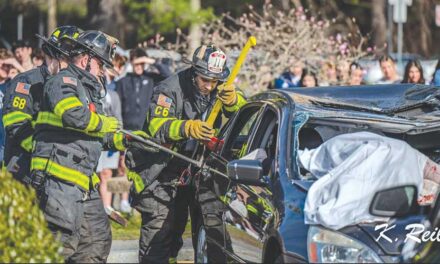Published in the April 12, 2017 edition
By MAUREEN DOHERTY
LYNNFIELD — Voters at April Town Meeting will not be asked to approve a cinema at MarketStreet after all. National Development has opted to defer the citizens’ petition proposed under Article 23 until at least the October Town Meeting.
Managing Partner Ted Tye made the announcement to the applause of the over 100 residents who packed the Al Merritt Center at MarketStreet on April 4 for a special selectmen’s meeting to discuss the particulars of this warrant article.
While still maintaining that a theater would be a beneficial asset to assure the continued success of the MarketStreet Lynnfield complex, Tye stated that the hundreds of conversations this proposal has generated since it was proposed a few weeks earlier convinced him and his team that extra time is needed for everyone to make an informed decision, particularly as it relates to the “parking and traffic aspects of the proposal.”
”This will give us more time to listen to comments, respond to input and give the town more time for careful consideration of the proposal,” Tye said.
Peer review OK’d
During the interim, Selectmen Chairman Phil Crawford proposed that an independent peer review traffic study be done by the town at the applicant’s expense. Tye agreed and the board directed Town Administrator Jim Boudreau to select a firm. Boudreau will work with Town Engineer Charlie Richter to select a firm and anticipated it would take at least two months to complete.
Selectman Dick Dalton also proposed that a subcommittee be formed to review the proposal that would include representatives from various town boards, public safety officials and at least one member the neighborhood, which also received the support of the board. Crawford said this subcommittee could hold a public meeting as early as June to review any findings up to that point.
Selectman Chris Barrett asked National Development to consider a one-year delay by not bringing this proposal back to the voters until April Town Meeting in 2018. Others in the audience asked for it to be put on hold for 10 or 20 years.
”The amount of time we need for the neighborhood to really understand the impact (of) parking and traffic and also the addition of the Lahey building” are among the important issues the town needs to consider in the coming months, Barrett said, adding he fully supports delaying this article and the peer review traffic study.
”There are a lot of changes coming to MarketStreet. We have to take a cautious approach,” Barrett advised, therefore waiting until next April would give all involved “a good amount of time to really study this issue and see what the impact is.”
Disclosure filed
At the outset of the meeting Dalton stated that he had filed a “disclosure of appearance of conflict of interest” statement because he resides at the Arborpoint apartments which are owned by National Development. He consulted with both town counsel and the state’s Ethics Commission and stated both agreed it would not be a conflict of interest for him to participate but he was advised to file the disclosure form.
“Ted (Tye) referred to it as a partnership. It truly is. We have a vested interest in how MarketStreet goes. It’s over $4M per year between real estate taxes and meals taxes – that’s seven percent of our budget, so it’s important for us to consider requests like this and keeping a place like MarketStreet the leading edge,” Dalton said.
Dalton added that in his job with the state he has toured many communities and worked with mayors and town managers who hold up MarketStreet “as an example of great development. They’re envious of what we have here and the real estate taxes that it produces. The amount of real estate taxes and meals taxes basically pays for our police department and fire department,” he said.
That being said, Dalton added this does not mean the town should not consider other concerns such as the traffic impact of this proposal. “We have an obligation to ourselves to investigate alternatives that can at least mitigate the traffic,” he said, adding he fully supported the peer review traffic study with a firm that would be “fully accountable to us.”
Police Chief David Breen said he would welcome the opportunity to be involved on this subcommittee, adding he was “prepared to speak at length about some of the concerns I had. I commend Mr. Tye’s move to have this taken off tonight although I wish I knew earlier.” Breen added MarketStreet “has always been very receptive to my concerns and I think we need this time to take a look at this.”
Tye’s pitch
During his presentation, Tye reviewed the benefits he believes MarketStreet has created for the town, including the donation of over 100 acres of land for the King Rail Golf Course and the donation of land that enabled the town to create the LIFE Senior Living community “that was sold by the town to generate funds, a significant portion of which went to building the turf fields.”
Tye stated the original plan approved when the land was rezoned by Town Meeting for MarketStreet 10 years ago included a mix of 475,000 square feet of retail and office space along with 180 residential units, the Arborpoint apartments. All of these apartments were required to be built in the first phase of the development, which was done.
”It called for upfront payments by the developer of $1.5 million to assist the town with its fiscal crisis,” Tye said. National Development’s goal from the time they first made this proposal to the town in 2006 was to work in “partnership” with the community. He does not believe they are breaking a “sacred promise” by returning to Town Meeting seeking this change in the development agreement because the “initial approvals called for any significant change in the plan to be brought back to Town Meeting for consideration.”
”The sacred promise – if there is one – has been that it is up to Town Meeting to decide. We look forward to giving voters sufficient information to make an informed choice,” Tye said.
Tye stated that while the town initially projected that MarketStreet would generate $1.8M in taxes annually, they are currently paying “$4.3M in annual taxes” with over 50,000 square feet still remaining to be built by right – that is without the need to seek any additional approvals from Town Meeting.
To keep their promise of not exceeding the 475,000 square foot threshold of retail and office space at MarketStreet, Tye proposed reducing the total square footage of office space by the exact square footage being requested for the theater – 39,000 square feet – while also limiting the theater to a location beside Gaslight The theater would be limited to no more than 40 feet in height with a maximum of eight screens and 800 seats, he said.
In response to a question from the audience, Tye said the two-story parking garage – which is allowed by right under the original 2007 agreement without further action required by Town Meeting – would be located beside the California Pizza Kitchen and accommodate nearly 400 cars.
Audience feedback
”The neighborhood felt ambushed by this proposal,” said Dave Basile of 15 Fernway, adding during this current campaign there was “zero reach-out to the neighborhood, so I’m hoping there will be stronger representation than a single member of the community for the effort that we put in trying to stay abreast of all these issues on our own time, on our own dime.”
”The traffic report, with it’s ‘imperceptible’ view of what would happen with a theater and a new medical center is laughable. When somebody comes off exit 43 trying to get home on a peaceful Sunday afternoon and it takes 10 minutes to get from being parked on 128 to my house, that traffic report is laughable,” emphasized Basile, to audience applause.
While MarketStreet has been good for the town’s tax base, it has been even better for National Development, Basile said, as it has an appraised value of $206M according to town records. He said if they are making five or six percent profit the complex is “very profitable” for its investors.
“Why would you squeeze the neighborhood even more, with a promise that there wasn’t going to be a theater? Work with us. Tell us what’s going on. Don’t ambush us,” Basile said, recalling the Feb. 14 meeting before the Planning Board when the medical building for Lahey Clinic was first proposed.
Basile said the neighbors put in a lot of effort trying to understand the impact of that proposal and those who questioned its location near Davio’s and suggested it be put in the back of the development on this open space near Gaslight were told: “‘That’s where the tenant wanted it,’ and two weeks later from that very first meeting with the Planning Board the website (to promote the theater) was set up on the 28th. This was well planned. I have to applaud the developer. They’re doing their work.”
”I hope there will be fair and even-handed representation from the neighborhood,” Basile said, but if that does not occur, he added, “we’ll go back to where we always have to go every two years, come back and defend our homes. We’re taxpayers. And I would be willing to bet just within the Lynnfield Water District, the tax revenues from that (property) are better than two times what is collected here so give us a fair and even-handed chance to understand what you are going to ram down exit 43 because (exit) 42 doesn’t work; it can’t be advertised.”
”And what is this rumored discussion of having another ramp coming off of Walnut Street? Put that to rest. Kill it quickly,” Basile said, to more applause.
Crawford initially asked to limit discussion to two residents given the revelation of the withdrawal of this article and in consideration of the board’s subsequent meeting on the town’s playing fields, but after those in attendance objected, he agreed to extend the discussion period for everyone who wished to speak. Eight additional neighbors offered their viewpoints, including one who spoke in favor of the proposal.
Jenn Lupien, 25 Melch Rd., said she bought her home 18 months ago “because of MarketStreet and we would look forward to a cinema,” but added she understands the neighbors’ concerns, believes that traffic is “a huge issue” and “would love to see what the answers are.”
Bob Xavier of 755 Walnut St. invited anyone who commutes down his street in the morning to stop by for coffee and “wait for the traffic to clear out” or “ride through gridlock from Route 1 all the way home.” He said a traffic study that does not include where people travel, which is on the side streets, would be worthless.
”All we’re doing here is pulling stores and commerce from Peabody at the Northshore Mall and other retail places so we may end up with a big pot of tax revenue, but we’re going to be surrounded by blight,” Xavier said.
Mary Dunn of Walnut Street said she moved to Lynnfield eight years ago for its “peace and tranquility and I still haven’t found it.” She requested clarification on whether the proposal would include either the medical building or the theater. Crawford explained the two-story medical building is allowed by right. She asked the town to consider requesting IDs from voters when they check in at Town Meeting. Crawford explained that voters get checked in but “we never ask for IDs.”
Ann Mitchell of 2 Fernway said she has lived in town since 1998. “When I moved here I thought I was moving from a city to a bedroom community near a golf course and we’ve had a lot of changes but MarketStreet’s here and I want it to succeed. When it was voted back in 2007, that was not the issue. The issue is we got an agreement that there would be no cinema and a large number off the neighbors agreed to support this project based on a representation that there would be no cinema.”
Traffic back-ups are now a huge concern for Mitchell, her family and her neighbors, so much so that it causes them to take alternate routes home all of the time, including getting off 128 at exit 41 even though she lives “right off exit 42” because it would take too long to get through the lights.
”This is not just a neighborhood traffic issue. This is a traffic issue that affects the whole town because when that’s backed up, people will come in exit 41,” Mitchell said, adding she hopes all residents understand the traffic generated by the medical building in addition to “an 800-seat cinema with shows morning, noon and night” will have a “huge traffic impact to this town. It’s going to be brutal for the neighborhood.”
To Mitchell, an eight-screen theater is a “multiplex” not a quaint, town center theater with a single screen. Given the rapid changes in the movie industry – including the possibility of offering customers the potential to pay a premium to watch new releases at homes upon their release to theaters – she questioned the long-term viability of a theater building that could be vacant in the future.
Wallace McKenzie, 4 Debston Ln., said the prohibition against a movie theater was not put into the development agreement itself but rather “it was put into the Zoning Bylaws and that was done because Zoning Bylaws take a two-thirds vote.”
McKenzie added, “It was done for a reason and at the insistence of the Planning Board so that any change like this would have to come back to Town Meeting.”
McKenzie said the neighbors did not raise objections when the original colonial look of the buildings as proposed was changed or when the width of the main street increased from 46 feet to 127 feet. But he cautioned that a discussion of what the signage for this proposed theater would look like must be on the table.
The 63 pages of design standards for MarketStreet, McKenzie said, are “riddled with ‘shoulds’ and ‘may’ instead of ‘shalls;’ those should be reviewed. Mr. Tye also mentioned the extra $400,000 of revenue. As part of the peer review I hope the selectmen will also ask for a financial review because we threw out numbers of $1.8M and now $4.3M” of revenue to be generated by MarketStreet, therefore a true “peer review” should include the costs expended and the taxes being generated.
Joe DeMaina of Alexander Road said he believes this request for a theater could fall under the definition of “spot zoning,” as he understood it from conversations with former Planning Board Chairman Richard O’Neil, is prohibited.
“The Planning Board’s intent was to have the tallest buildings at the back of the project; however, National Development has driven through the hole that says ‘should’ instead of ‘shall’” in those design standards,” DeMaina said. “If they really wanted to be good neighbors and if they really wanted to follow the intent of the town they would follow those ‘shoulds’ as if they were ‘shalls.’




